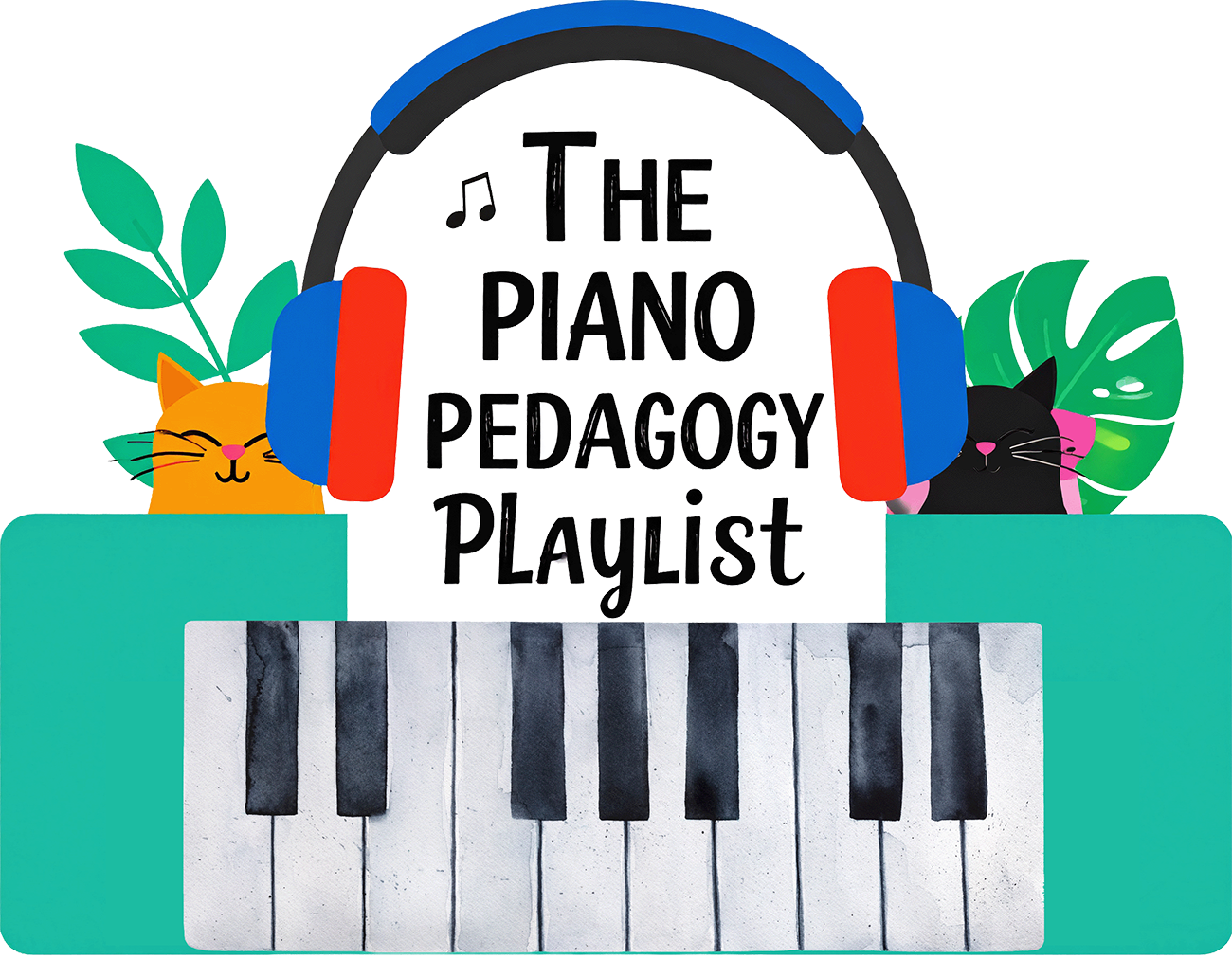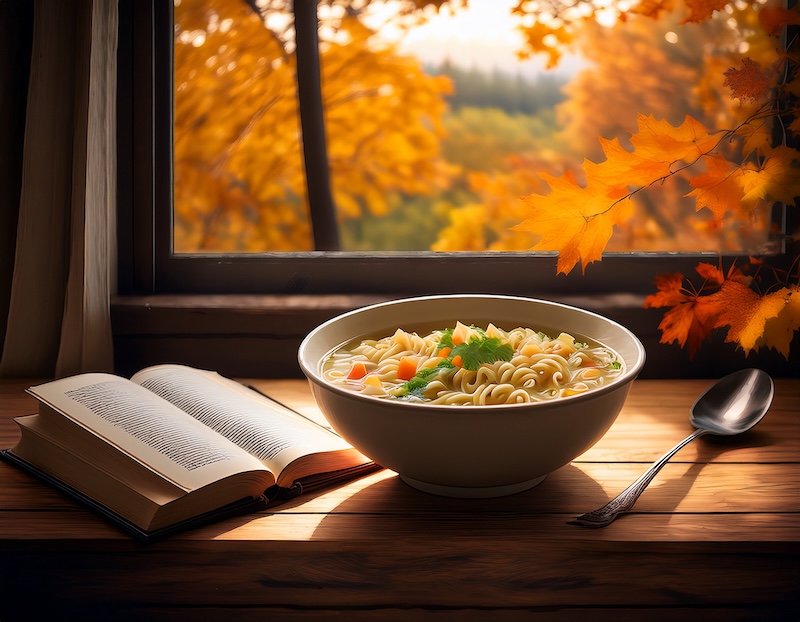
Featuring solos for late elementary level students (including adults!) from the collection, “Daily Comforts, volume 1” by Wynn-Anne Rossi.
Fresh Falling Leaves – Digital Download or Printed Copy
Long, Slow Walk – Digital Download or Printed Copy
Mystery Book – Digital Download or Printed Copy
Chicken Noodle Soup – Digital Download or Printed Copy
In this week’s episode, I feature four pieces from Daily Comforts, a collection of eleven lyrical piano solos by Canadian composer Wynn-Anne Rossi. Each piece celebrates the beauty of everyday life — from falling leaves to a cozy bowl of soup — and is paired with a short haiku to inspire imagination. Through impressionistic harmonies and gentle surprises, Ms. Rossi captures the feeling of peace found in simple moments.
— Transcript —
You know, lately, I’ve been thinking a lot about the little things that make life feel calm and grounded. Maybe it’s the changing of the seasons. Maybe it’s all the uncertainty that exists in the world right now.
But lately, the importance of these small daily comforts stands out even more. Things like a quiet walk, a favorite meal, a good book, or just taking a few minutes to sit at the piano and play something beautiful. These are the moments that help me to stay balanced.
This week’s episode celebrates these small but meaningful joys. The collection I’m featuring is called Daily Comforts by composer Wynn-Anne Rossi. Each of these late elementary pieces is titled after one of these simple everyday pleasures.
They are short pieces, somewhat impressionistic in style, and charmingly enough, each one is accompanied by a haiku to help set the mood. I invite you to pause with me and appreciate the beauty in small things. Daily Comforts coming up next on the Piano Pedagogy Playlist.
Greetings, everyone. I hope your day is going well. My name is Luke Bartolomeo. I’m a pianist, a teacher, and also a developer of apps for young music students, including Rhythm Swing and Flashnote Derby. Each Monday on the Piano Pedagogy Playlist, I share some of my current faves from the piano teacher’s repertoire. Music that I think has both educational value and is genuinely enjoyable to play and experience.
I think Daily Comforts fits that description quite well. In keeping with the season, I’ve again chosen to open with an autumn-themed piece. This one is called Fresh Falling Leaves, and the haiku that accompanies it goes like this.Reds, oranges, golds, and
greens dancing in autumn winds
paint the cool blue sky.
Simple and nostalgic. Fresh Falling Leaves is well suited for late elementary students who are beginning to explore the use of the pedal. In places, the pedal is held across many measures, allowing tonal colors to blend. In other places, it follows the changes in harmony, keeping things in clearer focus. This is a change for many pieces at this level, where the pedaling is much more predictable. It’s either hold the pedal for the entire piece, or otherwise it’s change the pedal every measure.
But here we have a more thoughtful and nuanced approach to pedaling. And this applies not only to this piece, but to all the pieces in this book.
The next piece we’re going to look at has an equally peaceful spirit. It’s called Long, Slow Walk. It features a simple, steady walking rhythm that isn’t in a hurry to get anywhere. It also makes good use of the Lydian mode.
So without belaboring the point, I might have the student start out by playing a G major scale, but raising the fourth note up to C sharp. Now obviously this would sound right away like a mistake to the student, but we could see then how this mistake is beautifully used to take us outside of our normal existence to a place of peace and tranquility.
For me, the most interesting music balances predictability with surprise, familiarity with hints of the unknown. Now, the pieces in this volume walk that tightrope perfectly. It never seems like the composer’s trying too hard to be original, but there are subtle surprises around every corner that make these compositions stand out from what we often find written for students at this level.
Our third Daily Comfort is called Mystery Book. Now, sometimes music conjures up very definite memories or sensations, and from the first moments of playing this piece, it reminded me of the old mystery series that I think still appears today on public television stations here in the US. The piece features a lot of cliches that we would probably expect from a piece in this genre.But pay special attention to the end, how the composer uses a deceptive cadence, and then extends the final phrase just enough so that we can’t really predict exactly when the end is coming. Until it does. Here’s Mystery Book.
Now, at first, including a piece called Mystery Book with a bunch of pieces that are supposed to depict Daily Comforts seemed a little bit out of place. I’ve always found mysteries to be a little stress-inducing. But then I thought about how much my wife enjoys binge watching on Brit Box shows like Father Brown and Death in Paradise when she needs to decompress at the end of a long day.
So I guess it makes sense. For some people, getting completely absorbed in a mystery is the perfect momentary escape from our daily stresses. Now our final piece is all about a daily comfort that I can more easily identify with, that of comfort food.
And in this case, it’s Chicken Noodle Soup. Listen for all of the cozy, familiar musical elements, peppered with just the right amount of unpredictability and well-seasoned harmonies.
Mmm, just like the real thing. Chicken Noodle Soup makes everything right in the world, for at least a minute or two. All of the pieces I’ve played for you today come from the collection Daily Comforts, volume 1, by Wynn-Anne Rossi.There’s also a volume 2 that we’ll have to take a look at in the near future. The pieces are designed for late elementary students, but they could also be used as sight-reading material for intermediates. There’s plenty of interpretive aspects to work on.
And don’t just consider these pieces for your younger beginning students. I would highly recommend these pieces to any adult students that you might have at this level. In fact, they might even more readily relate to the connections between the titles and the music.
If you’d like to explore these pieces yourself, you’ll find a link to Daily Comforts in the episode description. Or you can visit my website, pianopedagogyplaylist.com, and search for Episode 12. And just like that, we’ve slurped up the last drops of this episode of the Piano Pedagogy Playlist.
As you go through your week, I hope you’ll take a moment to notice your own daily comforts. A quiet cup of coffee, a chat with a friend, or maybe a few minutes at the piano. Not teaching, not previewing music for students, but just for yourself.
I’ll look forward to seeing you again next Monday, when I’ll play some more of What’s Good from the Contemporary Piano Teachers’ Repertoire. Until then, keep nurturing the music, and have a great week.




Leave a Reply